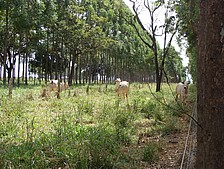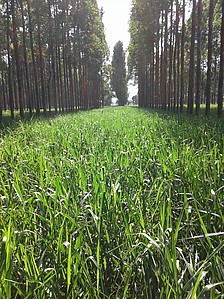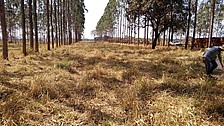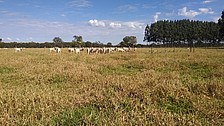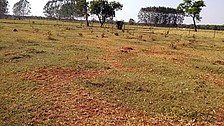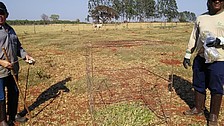Assesing the water footprint of beef cattle production in integrated systems in Central West Brazil
Mariana Pereira Barsotti
University of Hohenheim, Institute Agrcultural Science in the Tropics in cooperation with EMBRAPA Beef Cattle, Campo Grande - MS, Brazil
Challenges
The water footprint (WFP) is defined as the total volume of freshwater that is used to produce the goods and services consumed by an individual or a community (Hoekstra and Chapagain, 2008). The WFP of beef is much higher than of any other animal product, but greatly varies between production systems, mainly due to differences in liveweight gain and feed conversion efficiency of cattle (Mekonnen and Hoekstra, 2012).
Compared to continuous grazing systems, ICLF and ICL systems in Brazil provide mutiple outputs (tree, soy, grass, livestock) and have shown to be carbon-neutral (Alves et al., 2015). However, limited information exist on water use in these systems. Crop rotation and the inclusion of trees may alter water demand for fodder production, forage nutritional quality, as well as feed intake, thermoregulation, and behavior of grazing cattle, and thus their performance and of feed conversion, which in turn would influence the WFP of beef produced in these systems.
Current WFP estimates of Brazilian beef are rarely based on actually measured data, but rather use default values for input variables. Moreover, they do not account for seasonal differences in water demand for forage production and in the feed conversion efficiency in grazing cattle. All above-mentioned points lead to considerable uncertainties in WFP estimates. While advanced models exist to accurately simulate greenhouse gas emissions from cattle, current ruminant models fail to predict water demand for livestock production. In this line, an improved understanding of the interactions between environment and grazing cattle and their effect of feed and water use efficiency is essential.
Objectives
- Estimate the water use for feed production, drinking and elimination of waste products related to beef production in integrated and continuous grazing systems
- Understand interactions between environment and grazing cattle and its effects on feed and water intake, behavior, performance, and thus efficiency of feed and water use;
- Develop a semi-mechanistic livestock simulation tool to predict water demand and use in grazing-based livestock systems;
- Develop and compare different concepts to account for multiple outputs of integrated systems in WFP analysis; and
- Quantify the WFP of beef from different integrated and continuous grazing systems in Brazil using semi-mechanistic livestock modeling tools.
Expected results
- It will improve understanding of water fluxes and use for beef production under different land use systems (ICLF, ICL, and continuous pasture).
- a semi-mechanistic livestock simulation tool will be developed to predict WFP of beef from grazing-based systems.
- Approaches will be identified to adequately account for multiple outputs of pure livestock or integrated agricultural systems in water footprinting.
- The WFP of beef will be quantified which may affect consumer behaviour and promote the adoption of more water-efficient management strategies in cattle farming in Brazil.
Aims
To evaluate the Water Footprint of beef cattle production in ICLF and ICL systems in the Brazilian Cerrado.
Methods
The study will take place at the Embrapa Beef Cattle research station in Campo Grande, Mato Grosso do Sul, Central West Brazil. During the dry and rainy seasons, the blue, green, and grey WFP of beef cattle production will be analysed in three different production systems:
- ICLF system with Eucalyptus trees implanted in a 22x4 m²-grid, soybean as crop, Brachiaria as forage, and Nellore heifers as livestock component.
- ICL system without trees with soybean as crop, Brachiaria as forage, and Nellore heifers as livestock component.
- Common continuous pasture system with Brachiaria and Nellore heifers.
Each system will be replicated in three paddocks of 1.4 ha each. Measured and estimated parameters include:
Climate: Rainfall, temperature, relative humidity, global radiation and wind speed will be recorded continuously to estimate evapotranspiration. The thermal comfort of the animals will be evaluated by temperature and humidity index, black globe temperature and humidity index, and the radiant thermal load.
Soil: Soil moisture and soil chemical and physical properties.
Plant: Above ground net primary production, specific leaf area, forage nutritional value
Animal: Feed and water use efficiencies at animal level will be quantified from measured forage intake (double-marker technique), drinking water intake, and liveweight gain.
Furthermore The WFP of beef will be calculated following a life cycle assessment from calf production till slaughter and accounting for additional systems’ outputs by different approaches (e.g. system expansion, economic allocation; REF). Additional input variables such as water demand for other growth stages, soybean or Eucalyptus cultivation, or elimination of waste products will be collected from literature, other Embrapa Beef Cattle sites, local farmers, and livestock-related industry.
References
Alves, F.V., Almeida, R.G., Laura, V.A., Porfirio-da-Silva, V., Macedo, M.C.M., Medeiros, S.R., Ferreira, A.D., Gomes, R.C., Bungenstab, D.J., Reis, M. (2015). Carbon neutral Brazilian beef: a sustainable concept for beef production. In: World Congress on Integrated crop-livestock-forestry system. Brasilia, DF. Proceedings... Brasilia, DF: Embrapa, 2015.
Hoekstra, A.Y. and Chapagain, A.K. (2008). Globalization of water: Sharing the planet's freshwater resources. Oxford: Blackwell publishing. 208p.
Mekonnen, M.M. and Hoekstra, A.Y. (2012). A global assessment of the water footprint of farm animal products. Ecosystems. v.15, p. 401-415.
Publications:
- Pereira, M., De Almeida, R.G., Macedo, M.C.M., Dos Santos, V.A.C., Gamarra, E.L., Castro-Montoya, J., Lempp, B., Morais, M.D.G., 2021. Anatomical and nutritional characteristics of Megathyrsus maximus genotypes under a silvopastoral system. Tropical grasslands-Forrajes tropicales (forthcoming).
- Pereira, M., Morais, M.D.G., Fernandes, P.B., Dos Santos, V.A.C., Glatzle, S., De Almeida, R.G., 2021. Beef cattle production on Piatã grass pastures in silvopastoral systems. Tropical grasslands-Forrajes tropicales. 9, 1–12. doi.org/10.17138/tgft(9)1-12
- Glatzle, S., Stuerz, S., Giese, M., Pereira, M., de Almeida, R.G., Bungenstab, D.J., Macedo, M.C.M., Asch, F., 2021. Seasonal Dynamics of Soil Moisture in an Integrated-Crop-Livestock-Forestry System in Central-West Brazil. Agriculture 11, 245. doi.org/10.3390/agriculture11030245
- Barsotti, M.P.; de Almeida, R.G., Macedo, M.C.M. Laura, V.A., Alves, F.V., Werner, J., Dickhoefer, U., 2022. Assessing the freshwater fluxes related to beef cattle production: A comparison of integrated crop-livestock systems and a conventional grazing system. Agricultural Water Management. 269, 107665. https://doi.org/10.1016/j.agwat.2022.107665.

